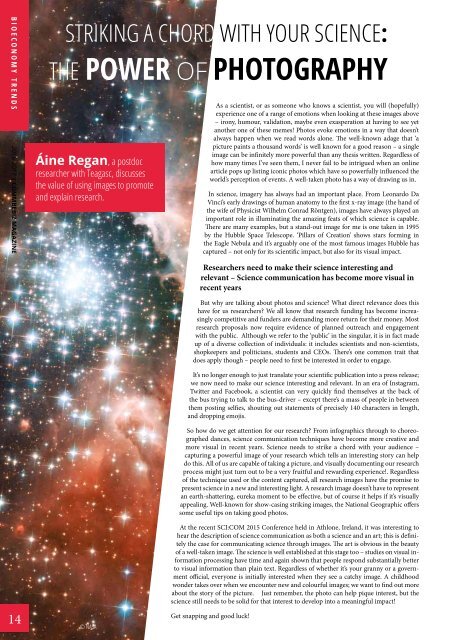BE INNOVATION_commbebiz-magazine 2016_2017
You also want an ePaper? Increase the reach of your titles
YUMPU automatically turns print PDFs into web optimized ePapers that Google loves.
BIOECONOMY TRENDS <strong>2016</strong>-<strong>2017</strong> | COMM<strong>BE</strong>BIZ MAGAZINE<br />
STRIKING A CHORD WITH YOUR SCIENCE:<br />
THE POWER OF PHOTOGRAPHY<br />
Áine Regan, a postdoc<br />
researcher with Teagasc, discusses<br />
the value of using images to promote<br />
and explain research.<br />
As a scientist, or as someone who knows a scientist, you will (hopefully)<br />
experience one of a range of emotions when looking at these images above<br />
– irony, humour, validation, maybe even exasperation at having to see yet<br />
another one of these memes! Photos evoke emotions in a way that doesn’t<br />
always happen when we read words alone. The well-known adage that ‘a<br />
picture paints a thousand words’ is well known for a good reason – a single<br />
image can be infinitely more powerful than any thesis written. Regardless of<br />
how many times I’ve seen them, I never fail to be intrigued when an online<br />
article pops up listing iconic photos which have so powerfully influenced the<br />
world’s perception of events. A well-taken photo has a way of drawing us in.<br />
In science, imagery has always had an important place. From Leonardo Da<br />
Vinci’s early drawings of human anatomy to the first x-ray image (the hand of<br />
the wife of Physicist Wilhelm Conrad Röntgen), images have always played an<br />
important role in illuminating the amazing feats of which science is capable.<br />
There are many examples, but a stand-out image for me is one taken in 1995<br />
by the Hubble Space Telescope. ‘Pillars of Creation’ shows stars forming in<br />
the Eagle Nebula and it’s arguably one of the most famous images Hubble has<br />
captured – not only for its scientific impact, but also for its visual impact.<br />
14<br />
© NASA<br />
Researchers need to make their science interesting and<br />
relevant – Science communication has become more visual in<br />
recent years<br />
But why are talking about photos and science? What direct relevance does this<br />
have for us researchers? We all know that research funding has become increasingly<br />
competitive and funders are demanding more return for their money. Most<br />
research proposals now require evidence of planned outreach and engagement<br />
with the public. Although we refer to the ‘public’ in the singular, it is in fact made<br />
up of a diverse collection of individuals: it includes scientists and non-scientists,<br />
shopkeepers and politicians, students and CEOs. There’s one common trait that<br />
does apply though – people need to first be interested in order to engage.<br />
It’s no longer enough to just translate your scientific publication into a press release;<br />
we now need to make our science interesting and relevant. In an era of Instagram,<br />
Twitter and Facebook, a scientist can very quickly find themselves at the back of<br />
the bus trying to talk to the bus-driver – except there’s a mass of people in between<br />
them posting selfies, shouting out statements of precisely 140 characters in length,<br />
and dropping emojis.<br />
So how do we get attention for our research? From infographics through to choreographed<br />
dances, science communication techniques have become more creative and<br />
more visual in recent years. Science needs to strike a chord with your audience –<br />
capturing a powerful image of your research which tells an interesting story can help<br />
do this. All of us are capable of taking a picture, and visually documenting our research<br />
process might just turn out to be a very fruitful and rewarding experience!. Regardless<br />
of the technique used or the content captured, all research images have the promise to<br />
present science in a new and interesting light. A research image doesn’t have to represent<br />
an earth-shattering, eureka moment to be effective, but of course it helps if it’s visually<br />
appealing. Well-known for show-casing striking images, the National Geographic offers<br />
some useful tips on taking good photos.<br />
At the recent SCI:COM 2015 Conference held in Athlone, Ireland, it was interesting to<br />
hear the description of science communication as both a science and an art; this is definitely<br />
the case for communicating science through images. The art is obvious in the beauty<br />
of a well-taken image. The science is well established at this stage too – studies on visual information<br />
processing have time and again shown that people respond substantially better<br />
to visual information than plain text. Regardless of whether it’s your granny or a government<br />
official, everyone is initially interested when they see a catchy image. A childhood<br />
wonder takes over when we encounter new and colourful images; we want to find out more<br />
about the story of the picture. Just remember, the photo can help pique interest, but the<br />
science still needs to be solid for that interest to develop into a meaningful impact!<br />
Get snapping and good luck!


